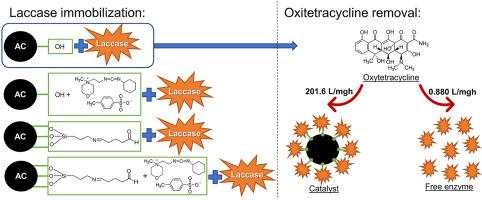Microporous and Mesoporous Materials ( IF 4.8 ) Pub Date : 2021-08-26 , DOI: 10.1016/j.micromeso.2021.111384 Jeniffer Blair-González 1 , Elsa Contreras-Villacura 1 , Andrea Carvajal Guevara 1 , Carolyn Palma Toloza 1

|
The presence of emerging pollutants in water matrices is an increasing concern; therefore, the development of sustainable technologies that enable the removal of these pollutants is required. The goal of the present study was to propose a methodology to prepare a sustainable catalyst using functionalized mesoporous activated carbon and an enzyme for the removal of oxytetracycline. Four strategies of laccase immobilization were evaluated using a 32 experimental design to evaluate the enzyme immobilization efficiency. The activated carbon was functionalized with hydrochloric acid, glutaraldehyde, or carbodiimide, resulting in four different enzyme immobilization carriers. The response variables evaluated were the protein-specific load capacity and specific activity of immobilized laccase. All developed carriers successfully immobilized the enzyme; among these, the carriers treated with hydrochloric acid and glutaraldehyde had significant protein-specific capacities with yields of 90%, while the carbodiimide carrier had a yield below 40%. In addition, the hydrochloric acid-treated carrier achieved the highest specific activity (168 ± 52 U/g) and specific protein load (13.48 ± 0.90 mg/g). The antibiotic removal assays that employed this catalyst showed better performance (100%) than the free enzyme, which was used as a reference. However, the apparent antibiotic removal mechanism was found to be pollutant adsorption instead of degradation, which was ascribed to the high affinity of the hydrochloric acid-treated carrier for the studied pollutant.
中文翻译:

生物/化学活性介孔碳去除土霉素
水基质中新出现的污染物越来越受到关注;因此,需要开发能够去除这些污染物的可持续技术。本研究的目的是提出一种使用功能化介孔活性炭和用于去除土霉素的酶来制备可持续催化剂的方法。使用 3 2评估酶固定化效率的实验设计。活性炭用盐酸、戊二醛或碳二亚胺官能化,产生四种不同的酶固定载体。评估的响应变量是固定化漆酶的蛋白质特异性负载能力和比活性。所有开发的载体都成功地固定了酶;其中,盐酸和戊二醛处理的载体具有显着的蛋白质特异性能力,产率为90%,而碳二亚胺载体的产率低于40%。此外,盐酸处理的载体实现了最高的比活性 (168 ± 52 U/g) 和比蛋白载量 (13.48 ± 0.90 mg/g)。使用这种催化剂的抗生素去除试验显示出比用作参考的游离酶更好的性能 (100%)。然而,发现明显的抗生素去除机制是污染物吸附而不是降解,这归因于盐酸处理的载体对所研究污染物的高亲和力。











































 京公网安备 11010802027423号
京公网安备 11010802027423号